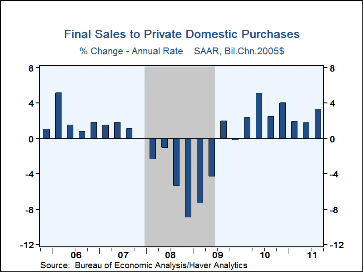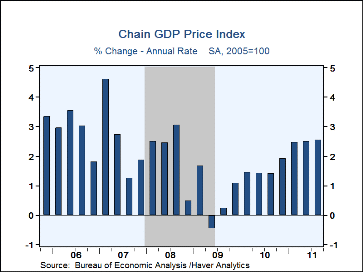 Global| Dec 22 2011
Global| Dec 22 2011U.S. GDP Growth Is Revised Lower Again
by:Tom Moeller
|in:Economy in Brief
Summary
Real GDP grew at a revised 1.8% annual rate in Q3 versus the earlier estimate of 2.0% growth. The figure fell short of Consensus expectations for an unrevised 2.0% rate of growth. Nevertheless, growth last quarter remained the [...]
 Real GDP grew at a revised 1.8% annual rate in Q3 versus the
earlier estimate of 2.0% growth. The figure fell short of Consensus
expectations for an unrevised 2.0% rate of growth. Nevertheless, growth
last quarter remained the strongest since 4Q'10. Continuing to lead growth
was business fixed investment.
Real GDP grew at a revised 1.8% annual rate in Q3 versus the
earlier estimate of 2.0% growth. The figure fell short of Consensus
expectations for an unrevised 2.0% rate of growth. Nevertheless, growth
last quarter remained the strongest since 4Q'10. Continuing to lead growth
was business fixed investment.
Accompanying the GDP numbers was the second estimate of corporate profits. They grew at a 6.9% annual rate (7.5% y/y), revised down from 8.5%. The latest was down from 13.7% growth during Q2. Domestic nonfinancial earnings grew at a 6.8% rate (11.6% y/y) which was down from a more than one-third Q2 rise. Financial sector earnings grew at a 9.1% rate (-6.9% y/y) while net earnings from abroad grew at a 4.9% rate (14.0% y/y).
Lesser growth in domestic final demand accounted for the reduced GDP growth figure. It was reduced to 2.7% from 3.0% mostly due to lessened 1.7% (2.0% y/y) rise in personal consumption. Growth in business fixed investment was raised slightly to 15.7% (9.1% y/y) but residential investment growth also was lessened to 1.2% (1.3% y/y). A 0.1 percentage point (-2.4% y/y) downtick in government spending was unrevised.
The 1.4 percentage point subtraction from GDP growth due to a lesser rate of inventory drawdown was little revised. A 0.4 percentage point addition from improved net exports also was little-changed. Exports grew at a 4.7% rate (6.0% y/y) and imports increased at a 1.2% rate (2.1% y/y).
The chain price index was notched up to a 2.6% rate of increase. This rate of growth is double that in 2010. The PCE deflator grew at an unrevised 2.3% rate (2.9% y/y) while business fixed investment prices rose at a heightened 1.8% rate (1.5% y/y). Residential investment prices ticked up at a 0.3% rate (1.6% y/y).
The latest GDP figures can be found in Haver's USECON and USNA databases; USNA contains basically all of the Bureau of Economic Analysis' detail on the national accounts, including the new integrated economics accounts and the recently added GDP data for U.S. Territories. The Consensus estimates can be found in AS1REPNA.
Would Active Labor Market Policies Help Combat High U.S. Unemployment? from the Federal Reserve Bank of Kansas City can be found here.
| Chained 2005 $, % AR | Q3'11 (3rd Est.) | Q3'11 (2nd Est.) | Q3'11 (Adv) | Q2'11 | Q1'11 | Q3'11 Y/Y |
2010 | 2009 | 2008 |
|---|---|---|---|---|---|---|---|---|---|
| Gross Domestic Product | 1.8 | 2.0 | 2.5 | 1.3 | 0.4 | 1.5 | 3.0 | -3.5 | -0.3 |
| Inventory Effect | -1.4 | -1.6 | -1.1 | -0.3 | 0.3 | -0.8 | 1.6 | -0.8 | -0.5 |
| Final Sales | 3.2 | 3.6 | 3.6 | 1.6 | 0.0 | 2.3 | 1.4 | -2.6 | 0.2 |
| Foreign Trade Effect | 0.4 | 0.5 | 0.2 | 0.2 | -0.3 | 0.5 | -0.4 | 1.0 | 1.2 |
| Domestic Final Sales | 2.7 | 3.0 | 3.2 | 1.3 | 0.4 | 1.8 | 1.8 | -3.6 | -1.0 |
| Demand Components | |||||||||
| Personal Consumption | 1.7 | 2.3 | 2.4 | 0.7 | 2.1 | 2.0 | 2.0 | -1.9 | -0.6 |
| Business Fixed Investment | 15.7 | 14.8 | 16.3 | 10.3 | 2.1 | 9.1 | 4.4 | -17.9 | -0.8 |
| Residential Investment | 1.2 | 1.6 | 2.4 | 4.2 | -2.4 | 1.3 | -4.3 | -22.2 | -23.9 |
| Government Spending | -0.1 | -0.1 | 0.0 | -0.9 | -5.9 | -2.4 | 0.7 | 1.7 | 2.6 |
| Chain-Type Price Index | |||||||||
| GDP | 2.6 | 2.5 | 2.5 | 2.5 | 2.5 | 2.4 | 1.2 | 1.1 | 2.2 |
| Final Sales of Domestic Product | 2.6 | 2.6 | 2.6 | 2.5 | 2.4 | 2.3 | 1.2 | 1.0 | 2.2 |
| Final Sales to Domestic Purchasers | 2.0 | 2.0 | 2.0 | 3.4 | 3.9 | 2.8 | 1.5 | -0.1 | 3.3 |
Tom Moeller
AuthorMore in Author Profile »Prior to joining Haver Analytics in 2000, Mr. Moeller worked as the Economist at Chancellor Capital Management from 1985 to 1999. There, he developed comprehensive economic forecasts and interpreted economic data for equity and fixed income portfolio managers. Also at Chancellor, Mr. Moeller worked as an equity analyst and was responsible for researching and rating companies in the economically sensitive automobile and housing industries for investment in Chancellor’s equity portfolio. Prior to joining Chancellor, Mr. Moeller was an Economist at Citibank from 1979 to 1984. He also analyzed pricing behavior in the metals industry for the Council on Wage and Price Stability in Washington, D.C. In 1999, Mr. Moeller received the award for most accurate forecast from the Forecasters' Club of New York. From 1990 to 1992 he was President of the New York Association for Business Economists. Mr. Moeller earned an M.B.A. in Finance from Fordham University, where he graduated in 1987. He holds a Bachelor of Arts in Economics from George Washington University.








